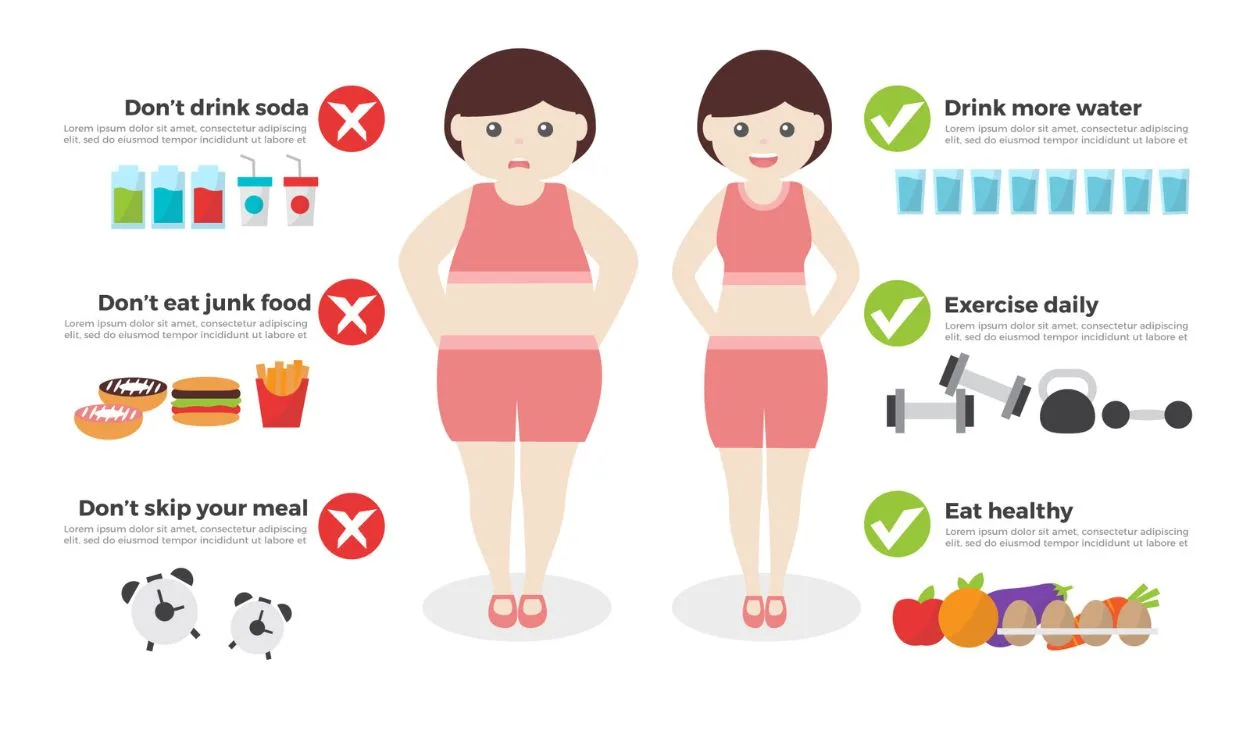Last Updated on May 2, 2024 by Silvy
Healthy Weight Management: Shedding Pounds and Building Smiles
Let’s face it, navigating the world of healthy weight management can feel like venturing into a jungle of fad diets and conflicting information.
You’re bombarded with promises of lightning-fast weight loss and unrealistic expectations. But what if we told you there’s a better way? A way that focuses on healthy habits, long-term goals, and feeling fantastic throughout the journey?
This guide is your trusty machete, hacking away the myths and misconceptions to reveal a path towards a healthier, happier you.
We’ll explore sustainable healthy weight management strategies, delve into the science of healthy eating, and equip you with the tools to conquer those cravings.
So, ditch the crash diets and buckle up – it’s time to rewrite your healthy weight management story!
Here’s what you can expect to find in this ultimate guide:
- Understanding Healthy Weight Management
- Unveiling the Calorie Equation
- Embracing the Power of Plate Planning
- Decoding Food Labels Like a Pro
- Befriending Fitness: Activities for Every Lifestyle
- Taming the Emotional Eater Within
- Prioritizing Sleep for Healthy Weight Management Success
- Building Sustainable Habits for Long-Term Results
- Conquering Common Healthy Weight Management Challenges
- Frequently Asked Questions (FAQs)
Unveiling the Mystery: Understanding Healthy Weight Management
Before we dive into the nitty-gritty, let’s establish a crucial fact: healthy weight management isn’t just about shedding pounds.
It’s about achieving a healthy weight that allows you to live a vibrant, fulfilling life. This means prioritizing your overall well-being and fostering a sustainable relationship with food and exercise.
Here’s the key takeaway: healthy weight management is a marathon, not a sprint. It’s about creating positive lifestyle changes you can maintain for the long haul.
Crash diets and quick fixes might offer temporary results, but they often leave you feeling deprived and frustrated. We’re here to help you ditch the yo-yo dieting cycle and embrace a sustainable approach to healthy weight management.
But how do you know what a healthy weight is?
There isn’t a one-size-fits-all answer. Body Mass Index (BMI) is a common tool, but it doesn’t account for factors like muscle mass and body composition.
Consulting a doctor or registered dietitian is the best way to determine your healthy weight range and create a personalized healthy weight management plan.
Cracking the Code: Unveiling the Calorie Equation in Healthy Weight Management
Calories are the fuel that keeps our bodies running. When we consume more calories than we burn, our bodies store the excess as fat.
Conversely, when we burn more calories than we consume, we create a calorie deficit, leading to healthy weight management.
So, how many calories should you aim for? This depends on several factors, including your age, gender, activity level, and current weight.
A registered dietitian can help you determine your ideal daily calorie intake for healthy weight management.
But remember, calories aren’t created equal! A bag of chips might have the same number of calories as a salmon fillet, but the nutritional value is vastly different.
Processed foods are often high in calories and low in nutrients, leaving you feeling hungry and unsatisfied. On the other hand, nutrient-dense foods like salmon provide essential vitamins, minerals, and protein, keeping you feeling fuller for longer.
Here are some tips for creating a calorie deficit for healthy weight management:
- Track your calorie intake: There are numerous apps and websites that can help you track your daily calorie intake. This allows you to become more mindful of your eating habits and identify areas for improvement.
- Focus on whole foods: Prioritize whole, unprocessed foods like fruits, vegetables, lean proteins, and whole grains. These foods are naturally lower in calories and higher in nutrients, keeping you feeling satisfied.
- Don’t skip meals: Skipping meals can actually hinder your weight management efforts. It can lead to overeating later in the day and disrupt your metabolism. Aim for regular meals and healthy snacks throughout the day to keep your energy levels stable and cravings at bay.
- Mindful portion control: It’s easy to underestimate portion sizes, especially when eating out or mindlessly snacking. Use smaller plates, measure out portions, and pay attention to your hunger and fullness cues to avoid overeating.
Remember, creating a calorie deficit is just one piece of the healthy weight management puzzle.
We’ll explore other crucial aspects like exercise, sleep, and emotional eating in the following sections.

Embracing the Power of Plate Planning for Healthy Weight Management
Feeling overwhelmed by meal planning?
Don’t worry, we’ve got you covered! Plate planning is a simple yet powerful tool for creating balanced and healthy meals that support your healthy weight management goals.
Think of your plate as a canvas for a masterpiece of nutrition.
Here’s how to fill it strategically:
- Half Your Plate for Fruits and Vegetables: These colorful powerhouses are packed with vitamins, minerals, and fiber. They’re naturally low in calories and high in water content, keeping you feeling full and satisfied. Aim for a variety of colors to ensure you’re getting a wide range of nutrients.
- A Quarter Plate for Lean Protein: Protein is essential for building and repairing tissues, keeping you feeling full, and boosting your metabolism. Lean protein sources like grilled chicken, fish, beans, lentils, and tofu are perfect choices.
- A Quarter Plate for Whole Grains: Whole grains provide sustained energy, fiber, and essential vitamins and minerals. Opt for brown rice, quinoa, whole-wheat pasta, or whole-grain bread over their refined counterparts.
- Healthy Fats for Flavor and Fullness: Don’t fear healthy fats! They play a crucial role in hormone regulation, satiety, and nutrient absorption. Include healthy fats from sources like avocados, nuts, seeds, and olive oil in moderation.
Here are some additional plate planning tips for healthy weight management:
- Limit processed foods: Processed foods are often high in unhealthy fats, added sugars, and sodium. They can sabotage your healthy weight management efforts and leave you feeling sluggish.
- Control portion sizes: Use smaller plates or bowls to prevent overeating. Pay attention to your hunger and fullness cues and stop eating when you’re comfortably satisfied.
- Season creatively: Herbs, spices, and low-sodium seasonings can add flavor to your meals without adding unnecessary calories. Ditch the salt shaker and explore a world of flavor possibilities.
- Make it visually appealing: We eat with our eyes first! Take the time to arrange your food in a visually appealing way. A colorful, well-plated meal is not only more satisfying but also encourages mindful eating.
Plate planning isn’t just about creating healthy meals; it’s about empowering you to make informed choices that support your healthy weight management journey.
Decoding Food Labels Like a Pro for Healthy Weight Management
In today’s fast-paced world, convenience often reigns supreme. But navigating the grocery aisles with a healthy weight management goal in mind can feel like deciphering a foreign language.
Don’t fret! Food labels are your key to unlocking the nutritional secrets of packaged foods.
Here’s how to become a food label decoding pro:
- Serving Size: This is crucial for understanding how much you’re actually consuming. Be mindful that a single serving size might be smaller than what you typically eat. Pay attention to the number of servings per container to calculate the total calorie and nutrient intake.
- Calories: This tells you how much energy a single serving of the food provides. Use this information in conjunction with your daily calorie goals for healthy weight management.
- Macronutrients: Look for the breakdown of macronutrients, including carbohydrates, protein, and fat. Aim for a balanced intake of these nutrients to support your body’s needs and promote satiety.
- Micronutrients: While not always listed in detail, some labels might showcase vitamins and minerals like Vitamin D, calcium, or iron. These micronutrients play vital roles in overall health.
- Sugar Content: Pay close attention to the amount of added sugar, not just total sugars. Added sugars contribute to empty calories and can hinder healthy weight management efforts.
- Fiber Content: Aim for foods rich in fiber, which keeps you feeling full for longer and aids digestion.
- Ingredients List: This is where the real magic happens! Ingredients are listed in descending order of quantity. Prioritize foods with whole, unprocessed ingredients at the top of the list.
Here are some additional tips for decoding food labels for healthy weight management:
- Beware of marketing claims: Don’t be swayed by flashy marketing terms like “healthy” or “low-fat.” Always check the label to verify the nutritional content.
- Compare similar products: Use the label information to compare similar products and choose the option that aligns best with your healthy weight management goals.
- Focus on the overall nutritional profile: Don’t get hung up on a single nutrient. Consider the overall picture: Is the food high in protein and fiber while keeping added sugars and unhealthy fats in check?
By becoming a food label decoding pro, you’ll be empowered to make informed choices that support your healthy weight management journey.
You’ll move from feeling confused to feeling confident in navigating the grocery store aisles!

Befriending Fitness: Activities for Every Lifestyle in Healthy Weight Management
Exercise isn’t just about burning calories; it’s a vital component of healthy weight management that offers a plethora of benefits.
It boosts your metabolism, helps build muscle mass, improves mood, and enhances overall well-being. But the thought of hitting the gym might not appeal to everyone.
The good news? You don’t need a gym membership or fancy equipment to reap the rewards of exercise.
Here’s how to find activities you’ll enjoy and incorporate them into your healthy weight management routine:
- Find Your Fitness Fun: The key to sticking with an exercise routine is to make it enjoyable. Explore different activities until you discover something you genuinely look forward to. Do you like dancing? Put on some music and have a living room dance party! Enjoy the outdoors? Go for a brisk walk, hike, or bike ride.
- Start Small and Gradually Increase Intensity: Don’t try to go from couch potato to marathon runner overnight. Begin with manageable activities and gradually increase the duration and intensity as your fitness level improves. Consistency is key!
- Embrace Variety: Mix up your routine to prevent boredom and target different muscle groups. Try bodyweight exercises one day, a swimming session the next, and a yoga class the following week.
- Make it Social: Find a workout buddy or join a fitness class. Having someone to motivate and support you can make exercise more enjoyable and help you stay accountable.
- Turn Everyday Activities into Workouts: Take the stairs instead of the elevator, park further away from your destination, or do some stretches while watching TV. Every bit of movement counts!
Here are some additional tips for incorporating fitness into your healthy weight management journey:
- Set realistic goals: Don’t aim to become a fitness fanatic overnight. Set achievable goals that gradually increase over time. Celebrate your progress along the way!
- Listen to your body: It’s okay to take rest days when you need them. Pushing yourself too hard can lead to injury and hinder your progress.
- Focus on how you feel: Shift your mindset from exercise being a chore to seeing it as a way to energize your body and boost your mood.
- Find a workout buddy or join a fitness class: Having someone to motivate and support you can make exercise more enjoyable and help you stay accountable.
Remember, even small changes can make a big difference.
By incorporating activities you enjoy into your routine, you’ll be well on your way to achieving your healthy weight management goals and experiencing the numerous benefits of exercise.

Taming the Emotional Eater Within for Healthy Weight Management
We all have emotional ties to food. Food can bring comfort, celebrate special occasions, and connect us to loved ones.
But sometimes, emotions can hijack our healthy eating habits and lead to emotional eating.
Emotional eating involves using food to cope with negative emotions like stress, anxiety, boredom, or loneliness.
It’s a common challenge that can sabotage healthy weight management efforts.
Here’s how to identify and tame the emotional eater within:
- Recognize Your Triggers: The first step is to identify the emotions that trigger your emotional eating. Are you more likely to reach for comfort food when stressed or bored? Journaling can be a helpful tool to track your emotions and eating habits.
- Develop Healthy Coping Mechanisms: Once you recognize your triggers, develop healthy coping mechanisms to deal with those emotions. Exercise, relaxation techniques like deep breathing or meditation, spending time in nature, or talking to a friend can be effective alternatives to emotional eating.
- Practice Mindful Eating: Pay attention to your hunger and fullness cues. Eat slowly and savor your food, focusing on the taste, texture, and aroma. This can help you avoid mindless eating driven by emotions.
- Don’t Deprive Yourself: Restrictive diets can often backfire and lead to cravings. Allow yourself to enjoy occasional treats in moderation. Aim for a balanced and flexible approach to eating.
- Seek Support: Don’t be afraid to seek support if you’re struggling with emotional eating. A therapist or registered dietitian can help you develop healthy coping mechanisms and create a personalized plan for managing your weight.
Here are some additional tips for managing emotional eating for healthy weight management:
- Plan your meals and snacks: Having healthy options readily available can help you avoid unhealthy choices when cravings strike.
- Don’t keep trigger foods around: If certain foods are your emotional eating downfall, avoid keeping them readily available at home.
- Practice self-compassion: Be kind to yourself. Emotional eating is a common challenge. Celebrate your progress and don’t get discouraged by setbacks.
By understanding your emotional triggers and developing healthy coping mechanisms, you can tame the emotional eater within and create a more peaceful and balanced relationship with food, supporting your healthy weight management journey.

Prioritizing Sleep for Healthy Weight Management Success
Sleep – often the most neglected yet crucial factor in healthy weight management. When you’re sleep-deprived, your body produces more ghrelin, the hunger hormone, and less leptin, the satiety hormone.
This hormonal imbalance can lead to increased cravings and overeating.
Here’s how prioritizing sleep can contribute to your healthy weight management success:
- Regulates Appetite Hormones: As mentioned earlier, sleep deprivation disrupts the production of ghrelin and leptin, leading to increased hunger and decreased feelings of fullness. Adequate sleep helps regulate these hormones, promoting healthy eating habits.
- Boosts Metabolism: While you sleep, your body undergoes repair and rejuvenation processes. This requires energy, and studies suggest that adequate sleep can boost your metabolism, helping you burn more calories throughout the day.
- Improves Impulse Control: When sleep-deprived, our willpower takes a hit, making it harder to resist unhealthy temptations. Getting enough sleep strengthens your impulse control, allowing you to make smarter food choices that align with your healthy weight management goals.
- Reduces Stress: Chronic stress can trigger cravings for sugary and fatty foods. Prioritizing sleep helps manage stress levels, promoting a calmer state of mind and reducing the urge to turn to food for comfort.

Getting Your Sleep On: Tips for a Restful Night
So, how much sleep do you actually need?
The National Sleep Foundation recommends adults aim for 7 to 9 hours of sleep per night.
Here are some tips to create a sleep-supportive environment and achieve restful sleep:
- Establish a Regular Sleep Schedule: Go to bed and wake up at consistent times, even on weekends. This helps regulate your body’s natural sleep-wake cycle.
- Create a Relaxing Bedtime Routine: Wind down before bed with calming activities like reading, taking a warm bath, or practicing light stretches. Avoid screen time for at least an hour before sleep as the blue light emitted can disrupt your sleep cycle.
- Optimize Your Sleep Environment: Make sure your bedroom is dark, quiet, and cool. Invest in blackout curtains, earplugs, and a comfortable mattress and pillows.
- Limit Caffeine and Alcohol: Avoid caffeine intake in the afternoon and evening, as it can interfere with sleep. While alcohol might make you drowsy initially, it disrupts sleep quality later in the night.
- Regular Exercise: Regular physical activity can improve sleep quality, but avoid strenuous workouts close to bedtime.
By prioritizing sleep hygiene and incorporating these tips, you’ll be well on your way to achieving a restful night’s sleep, which is a powerful tool for supporting your healthy weight management journey.

Building Sustainable Habits for Long-Term Healthy Weight Management
Crash diets and quick fixes might offer temporary results, but they’re rarely sustainable. The key to long-term healthy weight management lies in building sustainable habits that become an integrated part of your lifestyle.
Here’s how to cultivate healthy habits that support your weight management goals:
- Focus on Progress, Not Perfection: Don’t aim for perfection. Set realistic goals and celebrate small victories along the way. Remember, progress over perfection is key to long-term success.
- Make Gradual Changes: Trying to overhaul your entire lifestyle overnight is a recipe for overwhelm and failure. Start by making small, sustainable changes that you can easily incorporate into your daily routine. Gradually build upon these changes over time.
- Find an Accountability Partner: Having someone to support and motivate you can make a world of difference. Share your goals with a friend, family member, or join an online support group.
- Plan and Prep: Planning your meals and snacks in advance can prevent unhealthy choices when hunger strikes. Prepare healthy options ahead of time to avoid grabbing quick, processed foods.
- Cook More Often: Cooking at home allows you to control the ingredients and portion sizes. Experiment with healthy recipes and discover new favorites that nourish your body and taste buds.
- Stay Hydrated: Drinking plenty of water is essential for overall health and can also aid in weight management. Aim for eight glasses of water per day and track your intake if needed.
- Listen to Your Body: Learn to differentiate between true hunger and emotional cues. Pay attention to your body’s hunger and fullness signals and avoid mindless eating.
- Make Healthy Swaps: There’s no need to completely deprive yourself of your favorite treats. Find healthy alternatives that satisfy your cravings. Swap sugary sodas for sparkling water with fruit slices, baked sweet potato fries for regular fries, or dark chocolate for milk chocolate.
- Don’t Skip Meals: Skipping meals can disrupt your metabolism and lead to overeating later. Aim for regular meals and healthy snacks throughout the day to keep your energy levels stable and cravings at bay.
- Move Your Body Regularly: Find physical activities you enjoy and incorporate them into your routine. Aim for at least 150 minutes of moderate-intensity exercise per week, but even small bursts of movement throughout the day can make a difference.
Remember, building sustainable habits takes time and effort. Be patient with yourself, celebrate your progress, and don’t get discouraged by setbacks.
By focusing on progress, not perfection, and incorporating these tips, you can create a healthy lifestyle that supports your long-term weight management goals.

Conquering Common Healthy Weight Management Challenges
The road to healthy weight management is rarely smooth sailing.
Here are some common challenges you might face, along with strategies to overcome them:
- Hitting a Plateau: It’s common to experience weight loss plateaus where the scale seems stuck. Don’t get discouraged! Adjust your calorie intake or exercise routine slightly to keep your body adapting.
- Social Pressures: Social gatherings and celebrations can be tempting. Focus on mindful eating and enjoy smaller portions of your favorite treats. You can always politely decline unhealthy options.
- Travel Disruptions: Traveling can disrupt your healthy routines. Pack healthy snacks, research healthy restaurant options beforehand, and prioritize getting some exercise even if it’s just a brisk walk.
- Cravings: Everyone gets cravings! Plan healthy alternatives to satisfy your sweet or salty tooth. Fruits with a dollop of nut butter, air-popped popcorn with a sprinkle of spices, or a small square of dark chocolate are great options.
- Stress Eating: Learn healthy coping mechanisms to manage stress. Exercise, meditation, spending time in nature, or talking to a friend can be effective alternatives to emotional eating.
- Setbacks Happen: Don’t let a slip-up derail your progress. Acknowledge it, move on, and recommit to your healthy habits. Remember, progress over perfection!
Here are some additional tips for overcoming common healthy weight management challenges:
- Find a Support System: Having a cheerleader in your corner can make a big difference. Talk to a friend, family member, therapist, or join an online support group for encouragement and guidance.
- Focus on Non-Scale Victories: The scale isn’t the only measure of progress. Celebrate non-scale victories like increased energy levels, improved sleep, or fitting into your favorite clothes again.
- Enjoy the Journey: Focus on the positive changes you’re making to your health and well-being. Healthy weight management is a journey, not a destination. Enjoy the process of creating a healthier, happier you!
By understanding common challenges and having strategies in place, you’ll be well-equipped to overcome obstacles and stay on track towards your healthy weight management goals.
Frequently Asked Questions (FAQs) About Healthy Weight Management
How much weight can I realistically lose per week?
A safe and sustainable rate of weight loss is generally considered to be 1-2 pounds per week. Losing weight too quickly can be unhealthy and difficult to maintain in the long term.
Is it okay to weigh myself daily?
Weighing yourself daily can be discouraging due to natural fluctuations in weight throughout the day. Focus on weekly weigh-ins and track other progress markers like clothing fit or energy levels.
Do I need to completely give up my favorite foods?
No! Healthy weight management is about creating a balanced and sustainable lifestyle. Enjoy your favorite treats in moderation and find healthier alternatives when possible.
What are some healthy and easy snack options?
Here are some healthy and easy snack ideas:
- Fruits with nut butter
- Vegetables with hummus
- Greek yogurt with berries
- Hard-boiled eggs
- Air-popped popcorn with spices
- Cottage cheese
- Edamame pods
I don’t have a lot of time to exercise. How can I fit in physical activity?
Even small bursts of movement can make a difference! Take the stairs instead of the elevator, park further away from your destination, or do bodyweight exercises at home during commercial breaks. Every bit counts!
Remember, this FAQ section is just a starting point. There’s a wealth of information available on healthy weight management. Consult with a doctor or registered dietitian for personalized guidance and to create a plan that’s right for you.
Conclusion
Healthy weight management isn’t about achieving a specific number on the scale; it’s about creating a healthy and sustainable lifestyle that supports your overall well-being.
By incorporating the strategies outlined in this guide, you can develop a positive relationship with food and exercise, boost your energy levels, and feel your best.
Remember, progress over perfection is key. Celebrate your victories, big and small, and don’t be discouraged by setbacks. You’ve got this!
Disclaimer: This information is for educational purposes only and should not be construed as medical advice.
Always consult with a doctor or registered dietitian before making any changes to your diet or exercise routine.
Verified Sources:
- National Institutes of Health: https://www.niddk.nih.gov/health-information/weight-management/adult-overweight-obesity
- Centers for Disease Control and Prevention: https://www.cdc.gov/healthyweight/losing_weight/index.html
- Academy of Nutrition and Dietetics: https://www.eatright.org/




